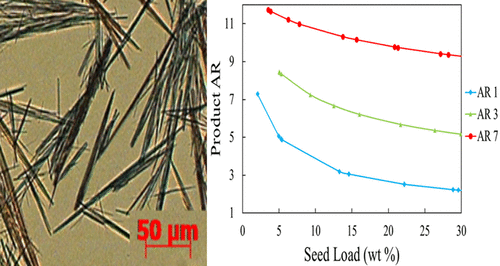当前位置:
X-MOL 学术
›
Org. Process Res. Dev.
›
论文详情
Our official English website, www.x-mol.net, welcomes your
feedback! (Note: you will need to create a separate account there.)
Comparison of One-Dimensional and Two-Dimensional Population Balance Models for Optimization of a Crystallization Process for a Needle-Shaped Active Pharmaceutical Ingredient
Organic Process Research & Development ( IF 3.1 ) Pub Date : 2022-03-28 , DOI: 10.1021/acs.oprd.1c00344 Tamar Rosenbaum 1 , Victoria Mbachu 1 , Niall Anthony Mitchell 2 , John Francis Gamble 3 , Patricia Cho 4 , Joshua D. Engstrom 1
Organic Process Research & Development ( IF 3.1 ) Pub Date : 2022-03-28 , DOI: 10.1021/acs.oprd.1c00344 Tamar Rosenbaum 1 , Victoria Mbachu 1 , Niall Anthony Mitchell 2 , John Francis Gamble 3 , Patricia Cho 4 , Joshua D. Engstrom 1
Affiliation

|
The two-dimensional population balance model (2D PBM) introduces the enhanced capability of modeling two different sets of growth kinetics, which can offer advantages to modeling crystallization processes that generate needle-like particles, a commonly encountered active pharmaceutical ingredient (API) morphology. Although one-dimensional population balance model (1D PBM) can be utilized effectively to model nonequant morphologies with the selection of appropriate shape factors, it cannot account for morphology or aspect ratio changes that can occur during the crystallization process. In this work, the advantage of the 2D PBM for an industrial crystallization process that generates needle-shaped API is highlighted by comparing the 1D PBM and 2D PBM results. The API utilized for this work had extremely slow desupersaturation and was not able to achieve solubility concentration despite an ∼50 h seed bed age. While the 1D PBM is useful in optimizing the crystallization process to enhance desupersaturation behavior, the 1D PBM did not match the particle size quantiles and, thus, could not be utilized to probe the impact of crystallization process parameters on the particle aspect ratio (AR). The 2D PBM was necessary to model the particle size quantiles and was utilized to further optimize process conditions for minimizing the particle aspect ratio. Simulations utilizing the 2D PBM indicated that, regardless of antisolvent addition rate or seed morphology, the final material would still have a high aspect ratio. This knowledge saved the investment of much time and effort in trying to minimize particle AR with changes in crystallization processing parameters alone and, thus, highlights the utility of the 2D PBM to the pharmaceutical industry.
中文翻译:

针状活性药物成分结晶过程优化的一维和二维种群平衡模型的比较
二维种群平衡模型 (2D PBM) 增强了对两组不同生长动力学进行建模的能力,这可以为生成针状颗粒的结晶过程建模提供优势,这是一种常见的活性药物成分 (API) 形态。尽管通过选择适当的形状因子可以有效地利用一维种群平衡模型 (1D PBM) 来模拟非量子形态,但它不能解释结晶过程中可能发生的形态或纵横比变化。在这项工作中,通过比较 1D PBM 和 2D PBM 结果,突出了 2D PBM 在产生针状 API 的工业结晶过程中的优势。用于这项工作的 API 具有极慢的去过饱和度,尽管种子床年龄约为 50 小时,但仍无法达到溶解度浓度。虽然 1D PBM 可用于优化结晶过程以增强去饱和行为,但 1D PBM 与粒度分位数不匹配,因此不能用于探测结晶过程参数对颗粒纵横比 (AR) 的影响. 2D PBM 是建模粒度分位数所必需的,并用于进一步优化工艺条件以最小化颗粒纵横比。使用 2D PBM 的模拟表明,无论反溶剂添加速率或种子形态如何,最终材料仍将具有高纵横比。
更新日期:2022-03-28
中文翻译:

针状活性药物成分结晶过程优化的一维和二维种群平衡模型的比较
二维种群平衡模型 (2D PBM) 增强了对两组不同生长动力学进行建模的能力,这可以为生成针状颗粒的结晶过程建模提供优势,这是一种常见的活性药物成分 (API) 形态。尽管通过选择适当的形状因子可以有效地利用一维种群平衡模型 (1D PBM) 来模拟非量子形态,但它不能解释结晶过程中可能发生的形态或纵横比变化。在这项工作中,通过比较 1D PBM 和 2D PBM 结果,突出了 2D PBM 在产生针状 API 的工业结晶过程中的优势。用于这项工作的 API 具有极慢的去过饱和度,尽管种子床年龄约为 50 小时,但仍无法达到溶解度浓度。虽然 1D PBM 可用于优化结晶过程以增强去饱和行为,但 1D PBM 与粒度分位数不匹配,因此不能用于探测结晶过程参数对颗粒纵横比 (AR) 的影响. 2D PBM 是建模粒度分位数所必需的,并用于进一步优化工艺条件以最小化颗粒纵横比。使用 2D PBM 的模拟表明,无论反溶剂添加速率或种子形态如何,最终材料仍将具有高纵横比。











































 京公网安备 11010802027423号
京公网安备 11010802027423号